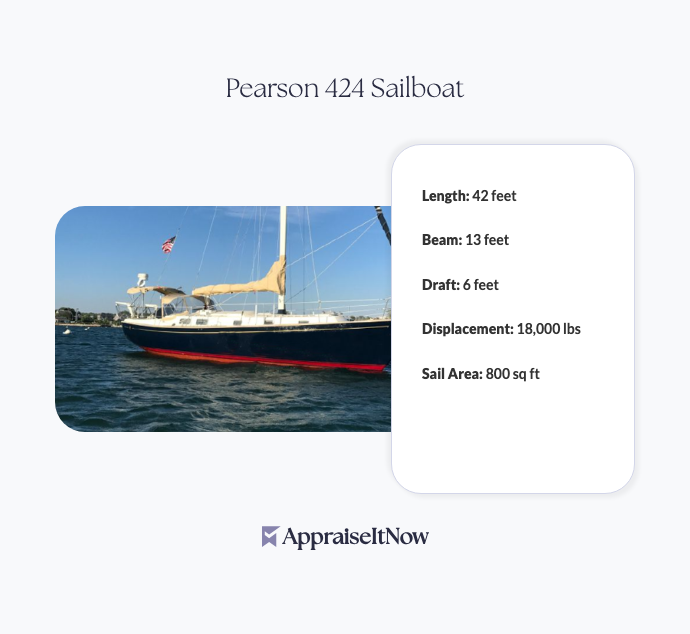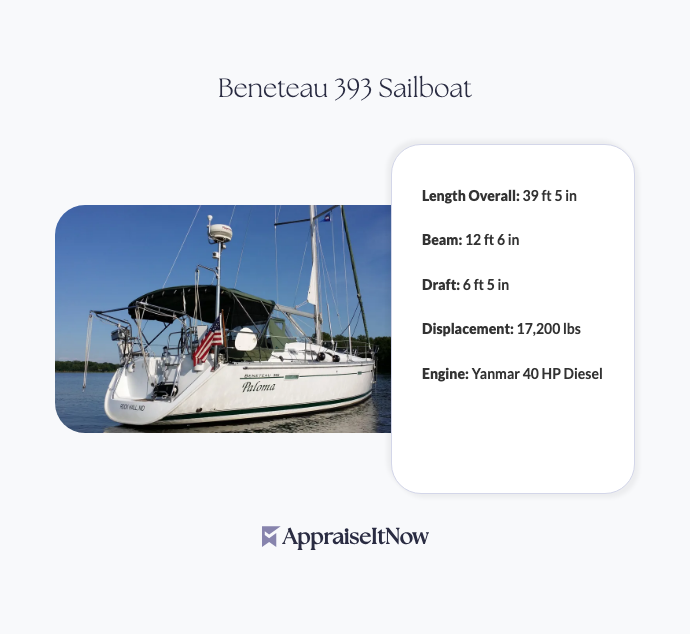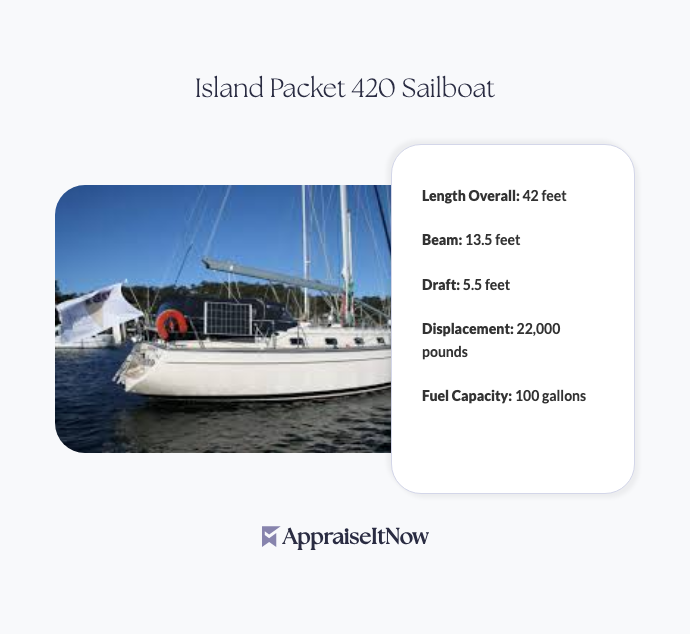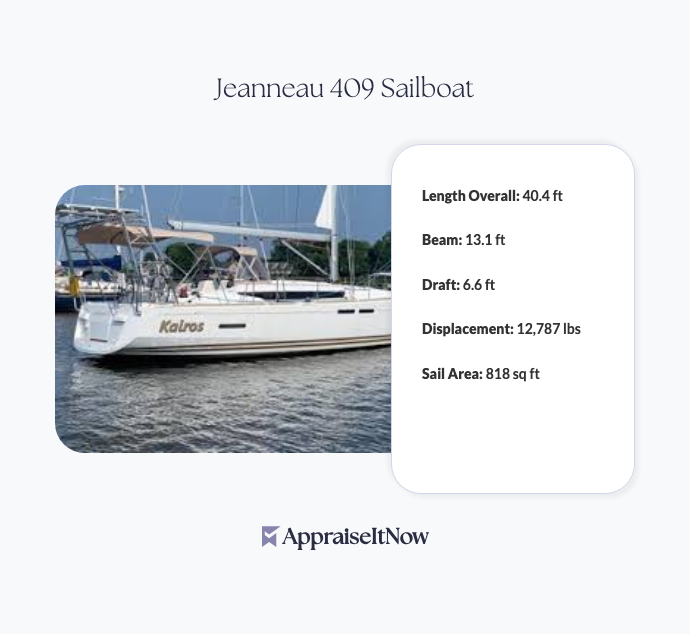<h1>How to Get Your Pearson 424 Sailboat Appraised</h1>
<p>The Pearson 424 is a well-respected mid-size sailing yacht that commands respect among cruising and racing enthusiasts. Whether you're selling, insuring, or evaluating your vessel for estate purposes, understanding how to obtain an accurate appraisal for your <strong>Pearson 424 sailboat</strong>—valued between <strong>$15,000 and $25,000</strong>—ensures you receive fair market value and proper documentation.</p>
<h2>Understanding Your Pearson 424's Market Position</h2>
<p>Introduced in 1974 and designed by the legendary Bill Shaw, the Pearson 424 represents a sweet spot in sailboat ownership. With its classic lines, fiberglass hull and deck construction, and robust inboard diesel engine, your Pearson 424 offers the kind of reliable engineering that hasn't declined significantly over decades. The model remains popular because it delivers genuine cruising capability without the complexity or expense of modern yachts.</p>
<p>Is a 30ft yacht suitable for crossing the Atlantic? While the Pearson 424 reaches approximately 42 feet in length, many owners successfully undertake significant cruising passages. This capability contributes to strong collector and active-sailor interest in the model, supporting stable market values. When considering whether a boat investment makes sense, the Pearson 424's reputation for seaworthiness and maintainability remains one of its strongest selling points.</p>
<div class="callout tip"><p><strong>Market Insight</strong></p>
<p>Pearson 424s with updated electronics packages and recent engine maintenance typically command values at the higher end of the $15,000-$25,000 range.</p></div>
<h2>Key Specifications That Impact Your Appraisal Value</h2>
<p>Professional appraisers evaluating your Pearson 424 examine specific technical and condition factors. The model's spacious three-cabin layout, roller furling genoa, and aft-facing cockpit design appeal to both serious cruisers and occasional weekend sailors. An original Raymarine electronics package—increasingly rare on vessels of this age—can add meaningful value if functioning properly and recently updated.</p>
<p>Your boat's condition across several dimensions directly affects appraisal accuracy. The fiberglass hull's structural integrity, engine hours and service history, quality of interior finishes, and functionality of systems like plumbing and electrical infrastructure all influence professional valuations. Understanding <a href="/blog/what-a-professional-boat-appraisal-includes">what a professional boat appraisal includes</a> helps you prepare documentation and address questions appraisers will ask.</p>
<table class='appraisal-table'>
<thead>
<tr>
<th>Factor</th>
<th>Impact</th>
<th>Details</th>
</tr>
</thead>
<tbody>
<tr>
<td>Engine hours</td>
<td>High</td>
<td>Diesel inboards over 3,000 hours reduce value</td>
</tr>
<tr>
<td>Hull condition</td>
<td>Critical</td>
<td>Cracks, osmotic blistering, or delamination significant issue</td>
</tr>
<tr>
<td>Electronics</td>
<td>Moderate</td>
<td>Updated nav systems add 10-15% premium</td>
</tr>
<tr>
<td>Interior updates</td>
<td>Moderate</td>
<td>Modern galley/head upgrades support higher valuation</td>
</tr>
<tr>
<td>Sails and rigging</td>
<td>Moderate</td>
<td>Recent replacements add $2,000-5,000 value</td>
</tr>
</tbody>
</table>
<h2>When Should You Get Your Pearson 424 Appraised?</h2>
<p>You'll want professional appraisal documentation when selling your vessel through a broker or private party transaction. Insurance companies increasingly require current appraisals to establish agreed-value coverage, protecting against underinsurance during the boat's useful life. The question of how much insurance costs on a $20,000 boat becomes easier to answer once you have professional documentation establishing replacement value.</p>
<p>Estate planning situations often require certified appraisals for property distribution among heirs or trust documentation. If you're contemplating <a href="/blog/boat-appraisals-and-estate-planning-what-you-need-to-know">boat appraisals and estate planning</a> considerations, obtaining appraisal documentation while you can provide detailed condition information serves your family's interests. Some owners also pursue appraisals during major repair or upgrade projects to document pre-work condition and establish values for insurance adjustment purposes.</p>
<div class="callout note"><p><strong>Legal Consideration</strong></p>
<p>USPAP-compliant appraisals provide legally defensible valuations accepted by courts, financial institutions, and insurance carriers—essential for estate, divorce, or dispute resolution purposes.</p></div>
<h2>Choosing the Right Boat Appraiser for Your Pearson 424</h2>
<p>Selecting an appraiser with specific experience in sailboats—particularly mid-range cruising vessels—matters significantly. While the Pearson 424 isn't exotic, appraisers should understand the model's construction techniques, common wear patterns, and market demand among active sailors. When <a href="/blog/what-to-look-for-in-a-boat-appraiser">selecting what to look for in a boat appraiser</a>, verify credentials from recognized organizations including the American Society of Appraisers (ASA), International Society of Appraisers (ISA), or American Association of Appraisers (AAA).</p>
<p>Your appraiser should have demonstrated expertise with fiberglass sailboats of the 1970s-1980s era and familiarity with cruising yacht markets specifically. Ask about their experience with comparable Pearson models and request references from recent clients. Digital appraisal services like <strong>AppraiseItNow</strong> connect you with credentialed specialists across the U.S. who understand regional market variations and can conduct thorough evaluations using photographs and detailed documentation you provide securely online.</p>
<p>Understanding <a href="/blog/determining-the-true-market-value-of-your-boat">the true market value of your boat</a> requires appraisers who examine comparable recent sales in your specific geographic market. Pearson 424 values can vary by 15-20% depending on regional demand, local storage costs, and buyer demographics. An appraiser familiar with your market area will produce more accurate valuations than someone unfamiliar with local conditions.</p>
<h2>Documentation to Gather Before Appraisal</h2>
<p>Prepare your Pearson 424 for professional evaluation by organizing key documentation. Gather engine service records showing maintenance history and current hour totals—diesel engines properly maintained often run 5,000+ hours reliably, while neglected engines become liability. Collect receipts for recent repairs, upgrades, or system replacements, as documentation of recent investment often supports valuation.</p>
<p>Include original purchase documentation if available, as well as any survey reports conducted during previous ownership transitions. Photographs showing the hull's exterior condition, interior cabin spaces, engine room, and systems provide valuable baseline documentation. Haul-out and bottom paint records demonstrate maintenance diligence that appraisers value. If your Pearson 424 has competed or achieved recognition in regional sailing events, documentation of these accomplishments can add collector interest and value.</p>
<div class="callout tip"><p><strong>Preparation Tip</strong></p>
<p>Organize documentation chronologically so appraisers quickly understand your boat's maintenance history and any modifications made from original specifications.</p></div>
<h2>Factors That Can Lower Your Pearson 424's Appraised Value</h2>
<p>Is buying a 20-year-old boat a bad idea? Not necessarily—but age combined with poor maintenance creates significant valuation challenges. Appraisers will downgrade your Pearson 424 substantially if they discover evidence of deferred maintenance, failed systems, or structural issues. Osmotic blistering in the hull, failed through-hull fittings that have caused water intrusion, or engine problems significantly reduce values within your estimated range.</p>
<p>Outdated electronics, while not deal-breakers, reduce appeal to modern sailors who expect GPS and electronic chart capability. A Pearson 424 with only mechanical steering, manual navigation, or completely non-functional instruments might see 10-15% valuation reductions. Interior deterioration from moisture, mold, or wood rot in the cabin structure creates health and safety concerns that appraisers note prominently in reports and valuations.</p>
<p>Major modifications from original design—particularly those affecting sailing characteristics or seaworthiness—can surprise appraisers negatively. Poorly executed upgrades or amateur installations reduce confidence in overall boat condition even if individual systems function. Documentation showing work by qualified marine technicians carries far more weight in appraisals than evidence of DIY modifications.</p>
<h2>Regional Market Variations and the 10% Rule for Yachts</h2>
<p>Pearson 424 values show meaningful regional variation. Boats in active sailing regions like the Pacific Northwest, Northeast, or Gulf Coast typically command premium prices compared to identical vessels in inland areas with smaller sailing communities. The question of what represents the best size sailboat for two people often leads sailors to exactly the Pearson 424's configuration—this market recognition supports values in coastal regions.</p>
<p>The "10% rule" for yachts suggests that boats depreciate approximately 10% annually during their first decade, then more slowly thereafter. Your Pearson 424, produced in the 1970s-1980s, has largely stabilized in value as classic cruising yachts. This actually represents excellent news compared to newer boats—your 40+ year old vessel holds value far better than a 20-year-old production boat, making it attractive to buyers seeking proven reliability.</p>
<p>Professional appraisers apply regional adjustment factors when establishing value, recognizing that a Pearson 424 in active use in Southern California maintains higher value than an identical boat requiring winterization in Minnesota. When <a href="/blog/determining-the-true-market-market-value-of-your-boat">determining true market value</a>, appraisers examine recent comparable sales specifically within your geographic region rather than national averages.</p>
<h2>Preparing for the Physical Appraisal Inspection</h2>
<p>When your appraiser visits, expect a comprehensive examination both above and below decks. Professional boat appraisers check structural integrity, examine the engine room thoroughly, test systems for proper function, and assess interior condition systematically. Can one person sail a 420? The Pearson 424 requires somewhat more skill due to size, but appraisers evaluate how well the vessel suits different sailor capabilities—an important market consideration.</p>
<p>Have your boat accessible with clean decks and organized interiors. While cosmetic appearance doesn't dramatically shift valuations, obvious neglect raises red flags. Appraisers appreciate organized documentation presented logically, and they'll request sea trial observations or confirmations about specific system functionality. If your diesel engine shows hours on the hour meter, be prepared to discuss maintenance intervals and any recognized issues requiring attention.</p>
<div class="callout note"><p><strong>Preparation Checklist</strong></p>
<p>Documentation organized, engine accessible, systems testable, hull clean, and interior presented in typical lived-in condition provides appraisers the information they need for accurate valuations.</p></div>
<h2>Understanding Your Appraisal Report</h2>
<p>Your completed appraisal will establish a specific value for your Pearson 424, typically within your estimated $15,000-$25,000 range based on condition and market factors. The report should justify this valuation through detailed condition assessment, comparable market analysis, and explanation of any adjustments applied. USPAP-compliant appraisals include photographs, specifications, and detailed descriptions supporting professional conclusions.</p>
<p>Use <a href="/blog/understanding-the-value-of-your-boat-with-a-professional-boat-appraisal">understanding appraisal values to make better decisions</a> about insurance coverage, whether to repair versus replace systems, or timing your sale. If selling, this professional documentation supports asking price justification. For insurance purposes, certified appraisals establish agreed value, preventing disputes if your Pearson 424 requires claims processing after damage or loss.</p>
<p>Professional appraisal services provide valuations accepted by maritime insurance carriers, financial institutions, and courts. Unlike casual online estimates or marina opinions, certified appraisals carry legal and financial weight appropriate for significant asset decisions.</p>
<hr />
<div class="callout note"><p><strong>Key Takeaway</strong></p>
<p>Professional appraisal of your Pearson 424 provides accurate documentation of your vessel's market value, essential for selling, insuring, or estate planning purposes. With credentialed appraisers examining condition across technical and market dimensions, you gain confidence that your classic cruising yacht receives fair valuation reflecting its proven reliability and continuing appeal among serious sailors.</p></div>







.avif)







